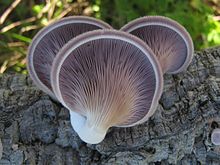| Lentinus strigosus | |
|---|---|

| |
| Scientific classification | |
| Kingdom: | Fungi |
| Division: | Basidiomycota |
| Class: | Agaricomycetes |
| Order: | Polyporales |
| Family: | Polyporaceae |
| Genus: | Lentinus |
| Species: | L. strigosus |
| Binomial name | |
| Lentinus strigosus Fr. (1825) | |
| Synonyms | |
| |
Lentinus strigosus is a species of fungus in the family Polyporaceae. It is edible when young, but becomes very tough with age.
Taxonomy
The species was first described by Lewis David de Schweinitz in 1822 as Agaricus strigosus in North Carolina.
Description
The expanded cap is semi-vase-shaped with an inrolled edge, usually purple then fading to brownish. The flesh is white, thin, and tough. The gills are close, narrow, and cap-coloured then whitish. The stipe is short, lateral and hairy. The taste is often bitter. The spores are white and smooth. Its habit includes parts of North America and the Philippines.
Similar species
Phyllotopsis nidulans is similar, but is orange-yellow and has a poor odour.
See also
References
- "Lentinus strigosus Fr., Systema Orbis Vegetabilis, 1: 77, 1825". MycoBank. International Mycological Association. Retrieved 2013-10-01.
- Miller Jr., Orson K.; Miller, Hope H. (2006). North American Mushrooms: A Field Guide to Edible and Inedible Fungi. Guilford, CN: FalconGuide. p. 141. ISBN 978-0-7627-3109-1.
- ^ von Schweinitz LD. (1822). "Synopsis fungorum Carolinae superioris". Schriften der Berlinische Gesellschaft Naturforschender Leipzig. 1: 20–131 (see p. 89).
- ^ Trudell, Steve; Ammirati, Joe (2009). Mushrooms of the Pacific Northwest. Timber Press Field Guides. Portland, OR: Timber Press. pp. 138–139. ISBN 978-0-88192-935-5.
- "In-vitro activity of ethanolic extract of Lentinus strigosus mycelia in N2 wild strain Caenorhabditis elegans – An animal model for obesity and its chemical composition" (PDF). Journal of Applied Biology & Biotechnology. 9 (1): 42.
External links
| Taxon identifiers | |
|---|---|
| Lentinus strigosus | |
This Polyporales-related article is a stub. You can help Misplaced Pages by expanding it. |